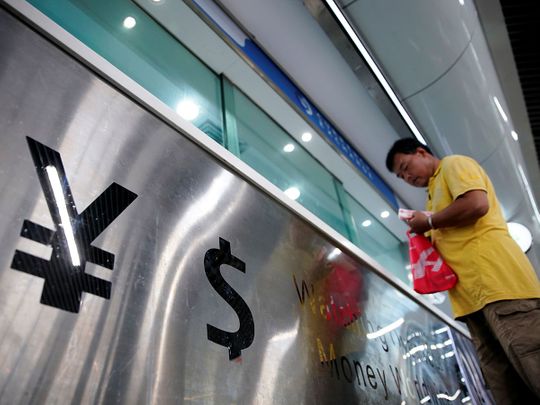
The onshore yuan fell to the weakest level in 14 years as the dollar strengthened on hawkish comments from a Federal Reserve member and as Covid-led lockdowns in parts of Xi'an intensified growth concerns.
The Chinese currency slumped to 7.2525 per dollar, the lowest since January 2008. That's after the US currency rose following Philadelphia Fed President Patrick Harker's comment that the central bank is likely to raise interest rates to "well above" 4% this year and hold them at restrictive levels to combat inflation.
Yuan under pressure
Pressure on the yuan has also risen as China sticks to its Covid Zero policy that's dragging down growth. Parts of the central metropolis of Xi'an were locked down for at least a week and other major hubs were rolling out virus restrictions. The prospect of a reduction in quarantine requirements for incoming travelers provided only a brief respite for the yuan on Thursday.
The central bank set a stronger-than-expected yuan fixing for the 37th straight session on Friday to support the currency with the twice-a-decade Communist Party congress currently underway. However, traders expect the People's Bank of China to loosen its grip on the yuan once the congress ends, according to Bloomberg survey.
Around 90% of the 30 yuan traders who responded to a Bloomberg survey this week forecast the People's Bank of China to ease its tight-ranged fixing after the summit wraps up on Saturday. Half of them said they expect the yuan to be pushed to 7.4 or even 7.5 per dollar within the year, and only 10% saw it staying at around the current level of about 7.25.
"I think China will allow the depreciation trend to resume and the fixing will climb again soon after the party congress," said Alvin T. Tan, head of Asia FX strategy at RBC Capital Markets. Upside pressure continues to build on dollar-yuan as US interest rates are pushing higher while yuan funding costs are tumbling, he said.
In addition to its stronger-than-expected fixings, the PBOC has also imposed a risk-reserve requirement of 20% on currency forward sales by banks and reduced the foreign-currency reserve requirement for banks to stem the yuan's losses.
Worst annual depreciation
Despite that, the yuan has declined versus 22 of the 24 trading peers' currencies in the CFETS basket in the past five days. The onshore yuan is set for the worst annual depreciation since 1994.
"We think the PBOC maintains FX stability now as the party congress is ongoing, but beyond this PBOC does not show strong intention to defend any specific levels of USD/CNY," said Peiqian Liu, chief China economist at NatWest Group.
She expects "fixing errors," or the gap between the fixing and forecasts, to ease off once the congress ends, although in the longer run "it depends largely on the dollar momentum when the PBOC gradually loosen its grip on fix."
Traders are waiting for the release of China's economic indicators, including gross domestic product, as the party congress nears its end. The GDP data was originally slated for release Tuesday but was delayed, with no reason or new publication date given, an unprecedented case which added to investor concerns.
China's economic uncertainty and the likelihood of widening US-China yield differentials mean the yuan is likely to stay soft into next week, particularly if the dollar retains its broad strength, said Carie Li, a global market strategist at DBS Bank in Hong Kong.












